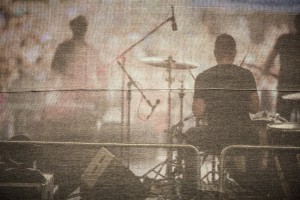Turn it Down: Reducing the Risk of Hearing Disorders Among Musicians
Posted on byHave you ever gone to a concert or performance and found your ears ringing on the way home? Imagine if that was your job and your ears were exposed regularly to such loud sound levels? Orchestra players, music teachers, conductors, DJ’s, band members, singers, sound engineers, and many others may be exposed to dangerously high music levels as part of their work. Professional musicians work and practice in a variety of venues, ranging from large music halls, theatres, and arenas to smaller clubs or music rooms in schools and universities. Overexposure to sound, both in terms of intensity and duration, is common. Musicians value and need good hearing for their jobs, but many are not fully aware of the risks associated with exposure to potentially harmful sound levels or the options for reducing these exposures without compromising their performance abilities.
Recently, NIOSH received a request for assistance in measuring and mitigating exposures during school band rehearsals (see the Health Hazard Evaluation report. Several professional musicians’ groups are starting to recognize the burden of hearing loss and tinnitus among musicians, and some have encouraged NIOSH to conduct research and provide guidance towards prevention (see input received in a public NIOSH Docket. As a result, NIOSH recently developed a Workplace Solutions document: Reducing the Risk of Hearing Disorders among Musicians. The document provides scientific justification, clarification, and an evidence-based perspective that musicians can trust and apply in their work and musical activities. Because being able to hear music is part of musicians’ work and the music is the direct result of the musicians’ deliberate action (vs. a side effect of heavy machinery), common “industrial” hearing conservation solutions may not be appropriate or effective.
Musicians have irregular and unpredictable exposures, and their work schedules are considerably different from those of typical industrial workers. Effective interventions must be behavioral and rely primarily on awareness, knowledge, competency, and accountability of those producing music.
NIOSH recommends that employers, music venue operators, schools and colleges, consider the following actions to reduce potential hearing damage for musicians, music teachers and students, and other exposed workers:
- Encourage participation in educational and awareness campaigns on music-induced hearing loss.
- Conduct regular sound level assessments to identify whether levels ever exceed 85 dB(A).
- If sound levels are above 85 dB(A), implement a hearing loss prevention program that includes annual hearing testing and training.
- Identify hearing protection solutions that work best for the individual musicians or affected workers.
Musicians should consider taking the following actions:
- Monitor the level and duration of your exposure to musical sounds. If professional sound measurement equipment are not available, some smartphone apps have provide useful and accurate information about sound levels see related blog.
- Play music at lower levels during individual and group rehearsals, whenever possible.
- Get a yearly hearing evaluation by a licensed audiologist.
- Give your ears some rest; take advantage of breaks in quiet areas when possible.
- Wear hearing protection when appropriate, some hearing protectors are manufactured and targeted specifically for musicians.
More information is available in a previous NIOSH science blog. This blog presented some approaches musicians can take to prevent hearing loss or tinnitus (ringing in the ears) from overexposure to sound. The blog highlighted contributions made by several Safe-in-Sound Excellence in Hearing Loss Prevention Award™ winners who pioneered efforts to reach musicians and other professionals exposed to music. In 2014, Benjamin Kanters, founder of the Hear Tomorrow program at Columbia College in Chicago, also received a Safe-In-Sound Award for Innovation in Hearing Loss Prevention for his work spearheading the Hearing Conservation Workshop. This workshop teaches hearing awareness and conservation to students in the fields of audio engineering, music recording, and hearing sciences.
Encouraging research also shows that practices and habits towards hearing health are changing among some professional musicians [O’Brien et al. 2015; Santucci 2010]. Awareness is also growing among those who attend concerts or night clubs [Beach et al. 2015; Beach et al. 2010]. Are you aware of other resources which we did not mention? Please share them and tell us about ideas and solutions you have about music exposure and hearing health.
Click here to download the complete “Workplace Solutions: Reducing the Risk of Hearing Disorders among Musicians.
Chucri Kardous, MS, PE is a research engineer with the NIOSH Division of Applied Research and Technology.
Thais C. Morata, Ph.D. is a research audiologist with the NIOSH Division of Applied Research and Technology and the Coordinator of the NORA Manufacturing Sector Council.
Christa L. Themann, MA, CCC-A, is an audiologist with the NIOSH Division of Applied Research and Technology.
Patricia L. Spears is a summer intern with the NIOSH Division of Applied Research and Technology.
Susan E. Afanuh, MA, is a technical informational specialist with the NIOSH Education and Information Division.
References
Beach EF, Nielsen L, Gilliver M [2015]. Providing earplugs to young adults at risk encourages protective behaviour in music venues. Glob Health Promot Feb 6.
Beach E, Williams W, Gilliver M [2010]. Hearing protection for clubbers is music to their ears. Health Promot J Austr 21(3):215–221).
O’Brien I, Driscoll T, Ackermann B [2015]. Description and evaluation of a hearing conservation program in use in a professional symphony orchestra. Ann Occup Hyg 59(3):265–276.
Santucci M [2010]. Saving the music industry from itself. Hearing J 63(6):10–14.
Posted on by


